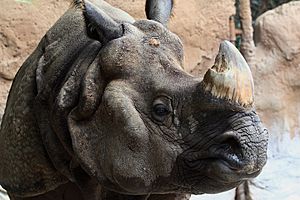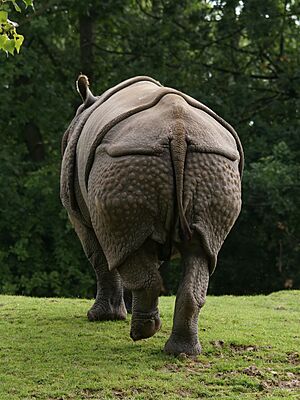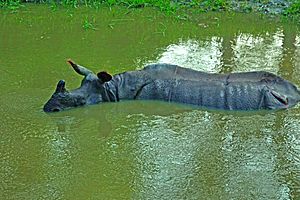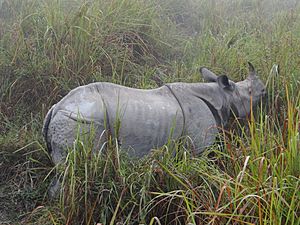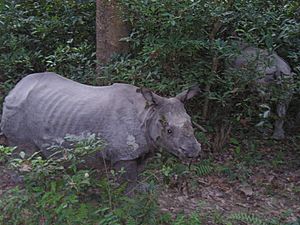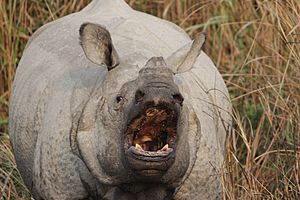Indian rhinoceros facts for kids
The Indian rhinoceros (Rhinoceros unicornis), also known as the greater one-horned rhinoceros, is a large mammal from the Indian subcontinent. It's listed as Vulnerable on the IUCN Red List. This means its population is at risk because its homes are shrinking and getting split up.
These rhinos once lived across a huge area called the Indo-Gangetic Plain. However, too much hunting and farming caused their numbers to drop a lot. Now, they only live in about 11 places in northern India and southern Nepal. In the early 1990s, there were about 1,870 to 1,895 rhinos. By 2015, their numbers had grown to an estimated 3,555 in the wild.
Quick facts for kids Indian rhinoceros |
|
|---|---|
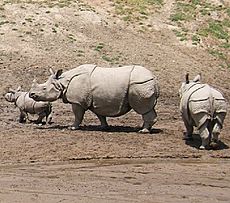 |
|
| Indian rhinoceros (from left to right: infant male, adult female, and juvenile female) | |
| Conservation status | |
| Scientific classification | |
| Kingdom: | |
| Phylum: | |
| Class: | |
| Order: | |
| Family: | |
| Genus: | |
| Species: |
R. unicornis
|
| Binomial name | |
| Rhinoceros unicornis Linnaeus, 1758
|
|
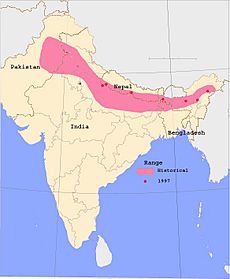 |
|
| Indian Rhinoceros range | |
Contents
What makes the Indian Rhino Special?
The Indian rhinoceros has thick, grey-brown skin that looks like armor plates. It has pinkish skin folds and a black horn. Its upper legs and shoulders have small, wart-like bumps. It doesn't have much body hair, except for its eyelashes, ear fringes, and tail brush. Male rhinos have big folds on their necks.
Both male and female rhinos have a single horn, but newborn rhinos don't have one. The horn is made of pure keratin, which is the same material as human fingernails. It starts to grow when the rhino is about six years old. For most adult rhinos, the horn is about 25 centimeters (10 inches) long. Some have been recorded with horns up to 36 centimeters (14 inches) long.
The Indian rhinoceros is the second-largest land mammal in Asia, after the Asian elephant. It is also the second-largest living rhino, smaller only than the white rhinoceros. Males are usually heavier than females.
The pinkish color of their skin comes from many blood vessels under the skin folds. These folds also help the rhino control its body temperature. Even with thick skin, they can still be bothered by biting flies, leeches, and ticks.
Where do Indian Rhinos Live?
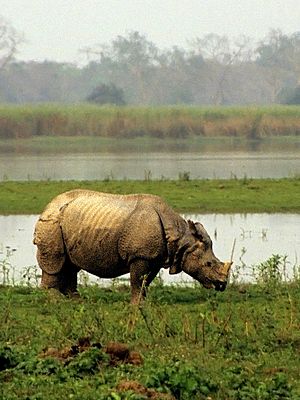
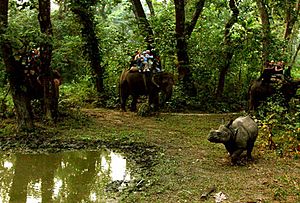
One-horned rhinos used to live all across the northern part of the Indian Subcontinent. Today, they are only found in a few areas in southern Nepal, northern Bengal, and the Brahmaputra Valley. In the 1980s, they were often seen in Royal Manas National Park in Bhutan.
Now, they mostly live in areas surrounded by human towns and farms. This means they sometimes go into nearby cultivated fields, pastures, and forests that have grown back. Sadly, rhinos are no longer found in Pakistan.
How Indian Rhinos Live and Behave
Adult male Indian rhinos usually live alone. Groups are often made up of females with their young, or up to six younger rhinos. These groups gather at muddy wallows (muddy pools) and grazing areas. Rhinos are most active in the early mornings, late afternoons, and at night. They rest during the hottest parts of the day.
They are excellent swimmers and can run very fast for short times, up to 55 kilometers per hour (34 mph). They have great hearing and smell, but their eyesight is not very good. Rhinos make over 10 different sounds to communicate. Male rhinos have their own areas, called home ranges, which can be about 2 to 8 square kilometers (0.8 to 3 sq mi). These areas often overlap.
Indian rhinos love to bathe regularly. The folds in their skin help to trap water, keeping them cool even after they leave the water.
Indian rhinos have few natural enemies. Tigers sometimes attack young rhinos that are not protected. However, adult rhinos are usually safe because of their large size. Birds like mynahs and egrets often eat insects from the rhino's skin and around its feet. Biting flies, leeches, and ticks can bother rhinos. They can also get diseases like Anthrax and a blood infection called septicemia.
What Indian Rhinos Eat
Indian rhinoceros are grazers. This means they mostly eat grasses. But they also enjoy leaves, branches from bushes and trees, fruits, and plants that grow in water.
They usually eat in the mornings and evenings. They use their lips to grab grass stems, bend them down, bite off the top, and then eat the grass. If the grass is very tall or it's a small tree, they will walk over it. They use their body weight to push the plant down so they can reach it with their mouths. Mother rhinos also use this trick to make food easier for their calves to eat.
Indian Rhino Social Life
Indian rhinos have different ways of living in groups. Adult males usually live alone, except when they are mating or fighting. Adult females are mostly solitary when they don't have calves. Mothers stay very close to their calves for up to four years after they are born. Sometimes, an older calf might even stay with its mother after a new baby arrives.
Younger male and female rhinos often form groups. Two or three young males might stay together on the edge of a dominant male's territory. This probably helps them stay safe. Young females are a bit less social than the males.
Indian rhinos also form temporary groups, especially at muddy wallows during the monsoon season and in grasslands in March and April. Up to 10 rhinos might gather at a wallow. These groups usually include a dominant male with females and their calves, but no young adult males.
Indian rhinos make many different sounds. At least 10 distinct sounds have been identified, including snorting, honking, bleating, and roaring. Besides sounds, rhinos also use smell to communicate. Adult males often urinate backwards, spraying urine up to 3–4 meters (10–13 feet) behind them, especially if they feel disturbed.
When Indian rhinos gather, they are often friendly. They might greet each other by waving their heads, rubbing against each other, nuzzling noses, or licking. Rhinos will also play-fight, run around, and play with twigs in their mouths. Adult males are usually the ones who start real fights. Fights between dominant males are the most common reason for rhino deaths. Males can also be very aggressive towards females during mating season. Males might chase females for long distances and even attack them head-on. Unlike African rhinos, the Indian rhino fights using its sharp incisor teeth, not its horn.
Images for kids
-
Indian rhinoceros in Chitwan National Park, Nepal
-
Indian rhinoceros at Bardia National Park
-
Mughal emperor Babur on a rhino hunt, 16th century.
See also
 In Spanish: Rinoceronte indio para niños
In Spanish: Rinoceronte indio para niños



